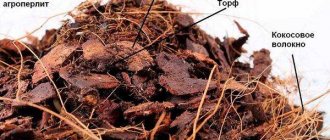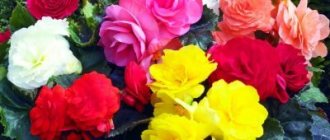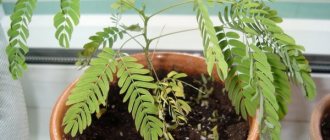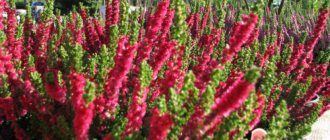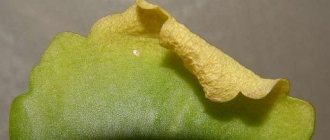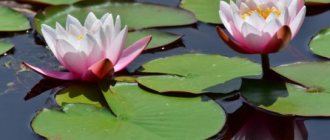The yellow water lily is a plant of incredible beauty. It grows on lakes, calm rivers, and in the backwaters of ponds. From time to time, this amazing flower can be found in the swamp, as it does not need clean water. Unfortunately, the yellow water lily is currently on the verge of extinction. The Red Book includes it in the list of rare plants.
Another name for the plant is “pod”. This is due to the interesting shape of the water lily's pistil. If you look closely, you can see its striking resemblance to a small jug. Many years ago, people used it to take water on long journeys, and sometimes even used it as a wallet. The leaf part of the white lily and the egg lily is surprisingly similar. These plants grow very often in a common body of water, and a non-specialist cannot immediately discern which leaves belong to the yellow water lily and which ones belong to the white lily. Only by looking closely can you find some difference between them, which lies in the cutout of the leaf near the petiole.
Yellow water lily: description
It is a perennial herbaceous plant. Belongs to the water lily family. Its rhizome reaches a length of 400 cm, large, fleshy, horizontal, covered with scars. The leaves are large, heart-shaped, oval, entire, long-petiolate, leathery. The flowers are solitary, floating on arrows, with yellow petals. The fruits are capsules with a large number of seeds. They ripen in mid-summer.
Kinds
The plant in question is a primitive species, from an evolutionary point of view. It is important to note that the egg capsule appeared more than thirty million years ago on Earth, which can be judged by a number of features.
- The plant has a perennial life form.
- Single flower.
- Spiral arrangement of bud parts.
- The flower has many stamens.
- The bud has radial symmetry.
- Stamens are solitary, not paired.
- Free parts of the perianth.
- Upper ovary.
The genus Kubyshka consists of eight plant species and three hybrids. All flowers are similar in structure and shade, but there are certain differences. Thus, a distinction is made between American and European species. Below are descriptions of some representatives of this plant.
- Arrowhead capsule. Its habitat is the USA, Virginia. Water lilies are often used to decorate water gardens or aquariums. The flowers of the plant are three cm in diameter, the leaves are arrow-shaped.
- Small jug. It has small flowers, leaves up to 20 cm, and grows in European reservoirs, Canada and Asia.
- Japanese. A plant whose leaves are under water, float on the surface and rise 20 cm above it. It is found in Asia.
- Small-leaved. It has leaves no more than 10 cm, flowers 3 cm, and grows in the eastern United States.
- Foreign. The flowers are yellow, greenish and brown. The stamens are red-red, the bud is up to 8 cm.
- Multi-petalled. Its leaves are large - 30 cm. The flower is up to 15 cm in diameter, 9 sepals.
There are also subspecies of the plant.
Blank
Healing preparations are made using the rhizomes of the plant. They are stored at the end of summer. Water lily rhizomes are washed, peeled, cut into small pieces and dried in the sun. They are left outdoors under a canopy or in ventilated rooms, spread out in a thin layer. The flowers are dried immediately at 50°C. But you need to take it into account when planning to use a plant such as yellow water lily for medicinal purposes - the Red Book includes it on the list of endangered plants.
What does it look like
The yellow capsule is a beautiful plant that adorns the quiet surface of the water. The yellow perennial flower proudly rises above the surface of the water, attracting with its modest but ancient beauty. Outwardly, it is very similar to an ordinary water lily, which includes about fifty species. Capsule is a well-known aquatic plant in Eurasia that prefers a temperate climate. Her image is often seen on the canvases of famous artists and frescoes. The egg lily is also called “yellow water lily”, but the plant is not related to lilies. Its flowers are regular in shape, quite large, with a double perianth. The egg lily loves light very much, so it seems to reach for the sun. It is unpretentious and tolerates shaded areas of reservoirs, as well as standing water.
Usage
The drug "Lutenurin", which includes yellow water lily, is used topically to treat diseases of the skin, mucous membranes, as well as for trichomonas chronic and acute diseases.
Traditional medicine uses yellow water lily for skin diseases, fever, inflammatory processes in the gastrointestinal tract, and heavy menstruation.
There is an assumption that a decoction of rhizomes helps with impotence and frigidity. An infusion of the plant's flowers is used as a sleeping pill, sedative, and antipyretic. In addition, it is used for bruises and gouty, joint, and rheumatic pain.
Capsule as a medicinal plant
All parts of this plant have medicinal properties.
:
- The flowers were used to treat rheumatism
; they also treated gout and were taken as a sleeping pill. - Compresses made from the leaves
were used to treat severe headaches, erysipelas and burns.
- Infusions from the rhizome
were taken for stomach pain, coughing, and relief from toothache. Beauties washed their hair with such infusions so that there would be no dandruff, and their hair would grow strong and healthy. - The water lily was used as an antipyretic, as medicinal decoctions and infusions for the treatment of skin diseases
, and it was used to treat the genitourinary tract.
Here are just a few recipes that have come down to us from our ancestors
:
- 2-3 tbsp. Brew spoons of water lily flowers with 1 cup of boiling water, wrap in gauze and apply to sore spots for gout or rheumatism
; - 1 tbsp. a spoonful of flowers is brewed in 0.5 liters of boiling water and taken 1 tbsp at night. spoon as a sedative and hypnotic
; - 1 tbsp. pour a spoonful of chopped rhizome with 1 cup of boiling water, cool and take 1 tbsp 3 times a day. spoon for stomach pain
; - Pour 2 tablespoons of crushed and dried flowers into 1 liter of boiling water. Boil it all for 10 minutes. over low heat, leave for 1 hour, squeeze and use as a compress as a wound healing agent.
All parts of the water lily have healing properties, but they are also poisonous. Therefore, decoctions and infusions should be prepared at home with extreme caution. Otherwise, instead of a positive effect, drowsiness, lethargy, vomiting, diarrhea and general malaise may occur.
All medications made from yellow water lily raw materials are prohibited for hypotensive patients.
, since this plant lowers blood pressure.
Wound healing decoction
Pour a liter of boiling water over 2 tablespoons of crushed dried flowers of the plant. Boil for 10 minutes over low heat. Then leave for 1 hour and squeeze out the raw materials.
Brew a glass of boiled hot water with a spoonful of yellow water lily rhizomes. Heat for half an hour in a water bath. Cool for about 10 minutes, then filter and squeeze out the raw materials. The volume of infusion must be brought to the original volume with warm water. Take a tablespoon three times a day. For douching, the infusion must be diluted with boiled water.
Yellow water lily is also used for poultices. To treat rheumatism and gout, poultices from the dried flowers of the plant are used. It is necessary to brew 2 tablespoons of raw materials with hot water, then wrap them in cloth. For a hypnotic and sedative effect, pour ½ liter of boiling water over a spoonful of the plant’s flowers and consume the infusion a spoonful at a time before bed.
Water lily (nymphea): types, planting, care, reproduction
The water lily, or more correctly water lily, is an unusually beautiful aquatic plant. The plant can often be confused with a lotus due to the shape of its flower. In Europe, the water lily flower is widespread and decorates many ponds in gardens and parks; it is especially loved in France.
In nature, the plant is found in reservoirs with stagnant water throughout almost the entire territory of Russia. The water lily will decorate any pond on the site and give it a fabulous look. The flower itself will bring many benefits to the owner due to its medicinal properties.
The external description of the water lily is as follows. This plant is perennial. It has a long, thickened, horizontally elongated rhizome. The root has many buds and branches. Foxes grow buds, and most of them are located on the surface of the water. Their shape resembles a heart.
The leaves are quite dense. Dimensions can reach up to 30 cm. Leaf color can be from green to light green, sometimes with brown or pink shades.
The water lily blooms early. The very first flowers appear in May and June. The total duration of flowering is until late autumn. The life of one flower is short, only four days. In the morning, flowers from the water column come to the surface, in the evening the flower closes and goes under water.
The water lily flower has a delicate aroma. The color of the flowers is different, there are yellow and red shades. The petals of the flower are oval-shaped with a sharp tip, large. They are located in several rows. The size of the flowers depends on the age of the plant and can be 15-20 cm in diameter.
The fruits of the water lily are shaped like a capsule containing the seeds. After ripening, the seeds from it fall onto the surface of the water, then gradually sink to the bottom of the reservoir. Then, after a certain time, they germinate.
In the natural environment, the number of lilies has sharply decreased. This was caused by intense water pollution and excessive harvesting of plants for economic purposes. Certain species have long been included in the Red Book.
Types of water lilies
There are more than forty species. The most famous types of water lilies: snow-white, white, tetrahedral, hybrid.
white water lily (snow-white): It lives in shallow ponds and lakes, with stagnant water, in the middle zone of our country. It has a very powerful and long rhizome. Straight and dense stems rise to the surface of the water. This species has underwater and above-water leaves, which are located on the surface of the water and are shaped like a heart. They can grow up to 30 cm in cross section.
Flowers are located on the leaves. The petals are large and milky white. The buds open after sunrise. They close and go underwater before the sun goes down. During and before rain, the buds remain closed. Flowering begins in May, with the largest number of flowers in mid-summer.
Flowering continues until late autumn. Can be successfully grown in a small pond on the site.
White water lily : An amazingly beautiful plant. It is found throughout Europe, in the Urals and the Caucasus, in Western Siberia, and on the Volga. The flowers are white with a creamy tint, with large petals on the outside and smaller ones on the inside. The core is yellow with large, several rows, stamens. Has disproportionate leaves.
Tetrahedral water lily : Rare species. It grows in lakes in northern Europe, North America, the Far East and Siberia. The species has small, triangular-shaped leaves with sharp ends. The flowers are not large with a small number of petals.
Hybrid type of water lily : Hybrid water lily varieties are created for gardeners. They are decorative and look impressive on the water. They feel good in artificial reservoirs. The color and size of the flowers are varied. There are varieties with decorative leaves that harmonize well with garden plants.
The most popular varieties are::
- Alba . Winter-hardy water lily, has white large flowers.
- Gold Medal . Golden color. Winter-hardy variety.
- Roseya . Pink shades of large inflorescences, winter-hardy.
- Blue Beauty . Blue water lily, not winter-hardy.
- James Brydon . Terry, cherry shade, winter-hardy.
All types of water lilies, as a rule, have white petals, sometimes pink. Do not confuse them with the yellow water lily - this is a different type of water lily.
Properties and composition
The water lily has amazing properties. All parts of the plant are used in medicine and cosmetics. Raw materials are prepared on an industrial scale. Active extraction of plants from the natural environment has led to the fact that some species are listed in the Red Book.
The roots of the plant are collected during the flowering period. They are cut and dried. The buds are collected unopened until seven o'clock in the morning. Dry in a well-ventilated area. Leaves can be collected throughout the entire period of plant development. They are also dried like other parts of the lily. Seeds are taken from the surface of the water and dried. All harvested raw materials can be stored for more than two years.
The rhizome contains tannins, alkaloids, starch, protein, acids, essential oils, and resins. Flowers contain cardiac glycosides. The leaves are rich in tannins and oxalic acid. The seeds contain a lot of fatty acids and essential oils.
Earlier we talked about another useful plant - Adonis.
The water lily is used as an antibacterial, anti-inflammatory, analgesic, and hemostatic agent. Indicated for various tumors, including malignant ones. A good sleeping pill is made from flowers. Also used for jaundice. The seeds are used for heavy periods. Tincture from the root will relieve purulent inflammation.
Lily is effective for neuroses, rheumatism, infections, and colds. Decoctions are used for tuberculosis and inflammation of the bladder.
Biological features of Water Lilies and Lotus
First, let's understand the terminology. The water lily and water lily are the same plant, the scientific name is nymphea. In general, the Water Lily family includes more than 50 species of plants. One of them is the water lily, which is also mistakenly called a water lily.
Lotus is the only representative of the Lotus family. This aquatic plant has significant biological differences from the Water Lilies, but there are also common features - the listed flowers are beautiful and grow in stagnant or slow-flowing waters.
Description of the lotus, in which regions it grows
The lotus flower reaches 30 cm in diameter and consists of many petals. Characteristic color: white and all shades of yellow, pink and blue. The lotus has three types of leaves: underwater, lying on the water and rising above the water surface on long petioles. The bud is also above the water, it is mobile: it always turns towards the sun, closes in the evening, and spreads its petals in the morning.
Lotus flowers and leaves rise above the water
The surface leaves of the lotus are shaped like a shield and have a velvety, rough surface. Therefore, drops of dew or rain linger on them and shimmer in the sun, like precious stones. But the main feature is hidden in the bud; in its very center there is an ovary in the form of a cone-shaped barrel. Seeds with a very dense shell ripen in it. There are many thread-like stamens around the ovary.
There is a cone-shaped ovary in the center of the bud
The natural habitats of the lotus are Southern Europe, North Africa, Central and South Asia, and in Russia - Krasnodar, Primorsky and Khabarovsk territories, Volgograd and Kursk regions, Kalmykia and Astrakhan. Only here you can plant and grow lotuses in your own pond. In the middle zone and northern regions you will have to be content with artificial lotuses or live water lilies.
Description of a water lily, or What grows in a pond
The water lily flower, or nymphaeum, is in no way inferior in beauty to the lotus; for some it is even prettier, since in the center of the bud there is no box, but only graceful stamens. This plant is called water lily. For gardeners, many varieties of nymphs with flowers similar to dahlias, roses, peonies, daffodils, and lilies have been bred. The colors and shades are the same as those of the lotus: white, yellow, cream, pink, lilac, etc.
Photo gallery: different varieties of water lilies
It is already clear which flower is common in Russian gardening and why. In most of our country, the climate is quite harsh, and water lilies are less demanding of heat and grow well in the middle zone and even Siberia. The main external difference from the lotus has already been named - there is no box in the center of the bud. The leaves of the water lily are different: they have an oval or rounded and heart-shaped shape, the surface is glossy, smooth, and water does not linger on it.
The water lily flower also closes at night, but is located directly on the water surface, like the leaves. They say that somewhere in the tropics there are water lilies with flowers and leaves on petioles, and for this they are mistakenly considered lotuses. This also happens in our latitudes, but the flowers are smaller and the petioles are shorter.
The leaves of water lilies are smooth and glossy, just like the flowers lie on the water, but some buds are raised on low petioles
What is the difference between a simple jug
This representative of the Kuvshinkovs has not yet attracted the interest of breeders and therefore grows in its original form throughout Russia, including the plains of the Urals and Siberia. It can be found in local swamps. The leaves of the egg pod are similar to a water lily, the flower is small - up to 10 cm in diameter, consists of 5-6 wide petals. On the outside they are greenish, on the inside they are yellow. Like a lotus, there is an ovary-barrel in the middle in which the seeds ripen.
The egg capsule also belongs to the Water Lilies, but has no decorative value
Interesting: the egg capsule flower smells of alcohol, which attracts pollinators.
The most striking representatives of aquatic plants are the lotus and water lily (nymphea). They differ in the structure of the flower and the type of leaves. But the main thing that a gardener needs to take into account when landscaping a pond is that lotuses grow only in warm and mild climates, while water lilies are satisfied with the conditions of most Russian regions.
Yellow egg capsule: application
Yellow capsule is used in pharmaceuticals, folk medicine, and cosmetology. Due to the content of nuflein in the chemical composition of plants, derivatives of the yellow water lily are used as a contraceptive. Homeopaths have successfully used the components of yellow water lily to treat frigidity in women and as a means of enhancing sexual activity. Yellow capsule extract is part of the pharmaceutical drug “Lutenurin”. The drug has proven itself to be quite effective in the treatment of such an unpleasant illness as trichomonas disease with bacterial and fungal complications. The drug is a three-gram suppository. It can be quite difficult to tolerate due to the “complex nature” of the yellow marigold. After all, the plant is poisonous.
photo 2
Diseases that the yellow egg capsule treats
If we name the diseases that the egg capsule can cure, then these are:
- gastritis;
- uterine bleeding;
- CNS diseases.
Use the capsule with caution to treat enuresis in children
In addition, medications made from it can be used to correct the functions of the reproductive system. A particularly positive effect is observed when drugs are used to eliminate painful nocturnal emissions, as well as when it is necessary to alleviate the course of impotence and restore lost sexual desire. This plant also helps women who want to get rid of such a phenomenon in the female body as frigidity.
Plant care
Decorative water lilies care for them is as follows. They are best suited for decorating small garden ponds or ponds. It’s great if the surface of the water has good lighting. A little shading will not hurt, but complete shade will not allow the plant to develop properly and the water lily may not bloom.
One plant will require from 1 to 4 square meters. area of the reservoir. There should be no flow of water or fountain. Water is still or with little movement.
Plants are planted at the border between May and June. Usually the root is placed in a bucket or container for greater ease of care. You can also place the rhizome at the bottom of the pond. It is better to remove the plant from the pond for the winter. This applies to small ponds with shallow depths that freeze completely in winter.
Soil for water lilies consists of the following components: garden soil, peat, river sand, compost.
During planting, the growing point is not buried. It should be at the top of the ground. After planting, pebbles are laid on the ground so that it does not wash out in the water. The depth at which the plant should be placed will depend on the variety.
As the plant grows, the container with the plant is moved deeper into the reservoir. This is done before the buds appear to speed up growth. Further, all movements are harmful to the nymph.
Feeding lilies
Responds well to bone meal as a fertilizer. To do this, flour is mixed with clay. Roll into small balls. Place on the bottom near the root.
When a lily is planted in a pond, they always take into account how winter-hardy it is. There are species that winter well in a pond. Basically these are all tall varieties that require good depth of the reservoir. Water lilies that are not winter-hardy are taken to a cold room without lighting until spring.
Water lily propagation
Reproduction of water lilies in artificial conditions requires some experience. It propagates by seeds only under natural conditions. The best results are obtained by the vegetative method of propagation. In this case, all actions must be done dynamically so as not to dry out the root.
In order to propagate the plant, the rhizome is taken out of the water and divided into parts. Each part must have at least one bud. The sections are disinfected with charcoal. Then they are placed in any available container filled with water and sludge. Existing leaves on the cut part of the root are removed.
Diseases
Lilies have a strong immune system. You should pay attention to them in hot summers if the plant grows in a shallow body of water. It can be damaged by aphids. In general, they will not harm the water lily, but the buds may not bloom.
Snails are lovers of succulent lily leaves. They must be removed mechanically. The chemicals are not good in the water, so the snails are collected. Aphids can be removed with a stream of water.
Beneficial features
The yellow capsule is not only a beautiful plant, but also a healing one. Useful properties are associated with the chemical composition. The water lily rhizome contains large quantities of sugar, resin, starch, tannins, and alkaloids. Among the latter are Nufloin and Nufaridin. The leaves of the plant contain many beneficial components.
These are sinapic, caffeic, and ferulic acids, including ellagitannins and luteolin. Flowers and seeds of yellow capsule contain nymphalin, tannins, and acids. Thanks to such a rich composition, this plant is successfully used in medicine. Medicines are made from the egg capsule that eliminate pain, disinfect wounds, and have a sedative, hypnotic, choleretic and diuretic effect.
Medicinal qualities of yellow capsule and contraindications
- Reptiles
- 72 facts about plants
- Animals of Siberia
- 35 facts about giraffes
- Animals of Crimea
- 36 facts about elephants
The healing properties of the yellow egg capsule are explained by the presence in its composition of chemical microelements and substances useful for the body. For example, it includes:
- alkaloids;
- tannins;
- luteolin;
- sinapic acid;
- various resins.
It is necessary to take drugs from the capsule only as prescribed by a doctor.
In total, this plant may contain more than 50 useful substances, so it is necessary to take drugs from it only as prescribed by a doctor, who can accurately calculate the dosage and therapeutic effect of a particular collection or infusion. Generally speaking, yellow capsule can be used as a bactericidal, diuretic, analgesic, astringent, hypnotic and sedative. At the same time, both leaves and flowers, rhizomes, and seeds can be used as medicinal raw materials.




